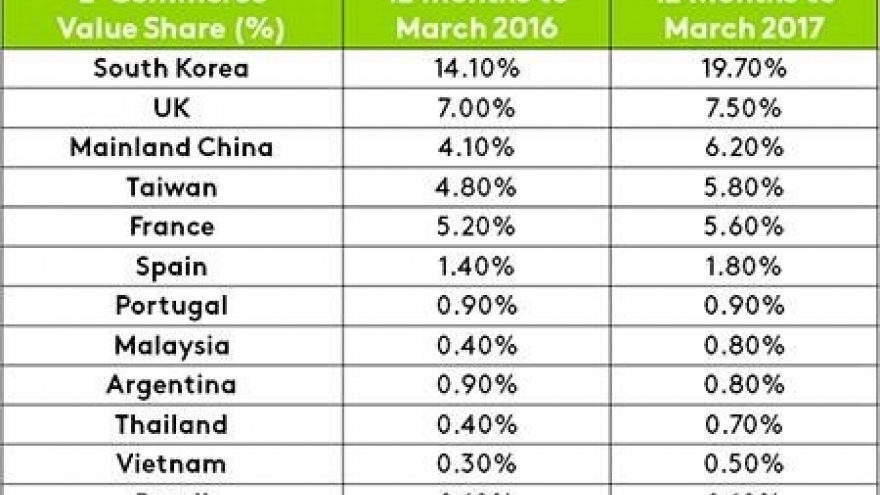New methods for e-commerce arise
As the online market has grown, firms are increasingly becoming savvier about the newest trends emerging from the digital transformation.
 |
Processing and supplying farm produce for domestic and overseas markets since 2013, Hanoi-based DACE Co. Ltd., has started digitalizing its sales strategy by launching a website to describe the firm’s products and business operations.
Wholesale orders and face-to-face contracts made up almost 80% of the firm’s revenue of more than US$30 million last year. However, the undeniable value of online retailing pushed DACE to start selling its products online since 2016, DACE director Tran Van Hieu said.
Aside from selling products on e-commerce platforms such as Shopee and Alibaba, DACE is eyeing an expansion of sales on Lazada Vietnam and Amazon.
The firm is contemplating several ideas to increase online retailing, Hieu revealed without going into detail.
According to a 2016 survey of local export-import enterprises by the E-commerce and Information Technology Agency (now known as the E-commerce and Digital Economy Agency) under the Ministry of Industry and Trade, 49% of surveyed firms owned a website, 32% set up business relations with foreign partners through online channels, and just 11% joined e-commerce platforms.
Since 2010, selling products through website, social media, search engines, and mobile messages has taken over Vietnam’s e-commerce market. “Now, the ongoing digital transformation is forcing retailers in Vietnam to think more about digital sales strategies, how to collect customer data, and how to analyze consumption trends,” Ha Anh Tuan, CEO of Vietnam’s marketing research company Vinalink, told the Vietnam Internet Day 2017 event, held in Hanoi in late November.
Popular sales channels in Vietnam such as e-commerce platforms, Facebook, Zalo, and websites are cooling off compared to other methods spreading in foreign markets.
An emerging method called ‘native ads’ allows sellers to post their advertisements alongside regular articles on online newspapers. This application has been gaining traction in Vietnam.
Meanwhile, firms like Foody, Uber, and Grab are selling products or services based on consumer location. In addition, the use of mobile all-in-one apps for online retailing is increasing.
For instance, Grab is reportedly planning to sell other products and services with online payments in addition to providing transportation services, because the service provider can reach a large group of customers, Tuan said.
He stressed that marketing automation is becoming an effective method for online selling. According to him, 92% of local small businesses lose money every month because they ignore marketing automation.
Marketing automation works through data collection, and allows firms to automate repetitive tasks like sending emails about products, services, promotions, and discounts. It actively collects the found information and divides the customers into different groups, based on the times they check emails and search for products.
The groups then serve as useful references for sellers to offer products that are relevant to the customer.
Leveraging the information of website visitors or other internet users is an alluring prospect for foreign investors eyeing an expansion into the Vietnamese market, said Nguyen Ky Minh, director of the Ministry of Industry and Trade’s E-commerce Development Centre.
Alexandre Dardy, CEO of Lazada Vietnam, told VIR that in the digital era, data is the most valuable asset a business can have. “With the advantage of being the leading e-commerce platform, we are able to measure, analyze, and understand the behavior of millions of users shopping on Lazada, which helps us improve our service.”
Lazada is offering a personalized and customized onsite experience to fit individual profiles, based on the search history of the user.
“By further investing in technology innovation, we would like to bring the customer shopping experience into the next level,” added Dardy.
The local e-commerce market grew by 22% in 2016, reaching revenue of US$4 billion. Still, e-commerce makes up just around 3% of the national goods and services retail revenue.
Taking part in a recent ASEAN-Taiwan e-commerce dialogue held in Taiwan, Minh of the Ministry of Industry and Trade stated that Vietnam’s e-commerce market is of major interest to foreign investors. Vietnam is consistently listed among the region’s top two or three countries with the most potential for e-commerce investments.
He said the market is expected to see growth rates of up to 30% by 2020, with total revenue of US$7-10 billion, indicating ample room for foreign investors. “Domestic sellers have advantages when approaching local customers thanks to the common language, but they are weak in administration, technology, and selling techniques.”
Minh recommended that foreign e-commerce companies should aim to win over and better support local customers with technical services or applications that keep societal developments in mind, which remains a challenge for domestic firms. Facebook advertising and Uber exemplify the trend.
According to the Vietnam E-commerce Association, despite the existence of major obstacles such as low consumer trust in online shopping and unqualified delivery and fulfillment services, the Vietnamese market continues to seek new sales channels.
The trend of omni- or multi-channel sales has gained traction in Vietnam since the country’s largest e-commerce event – Online Friday – was held in December 2016 and sent orders soaring. The single-channel retail method, which means selling only at stores or online, will gradually decline and be replaced by the omni-channel retail method, according to the Vietnam Retailers Association.
Accordingly, the omni-channel retail method plays a key role in approaching and connecting customers in the digital economy. Sellers should create compelling shopping experiences for customers with three-dimensional imaging technologies, virtual reality apps, and the integration of mobile use.
VEA cited a Nielsen study in its e-commerce index report for 2017 that the boundary between the real world and virtual world has faded, even in the field of commerce. The combination between “real” and “virtual” elements increases convenience for customers, and customers’ price comparisons also take place in digital space, especially on mobile phones.


